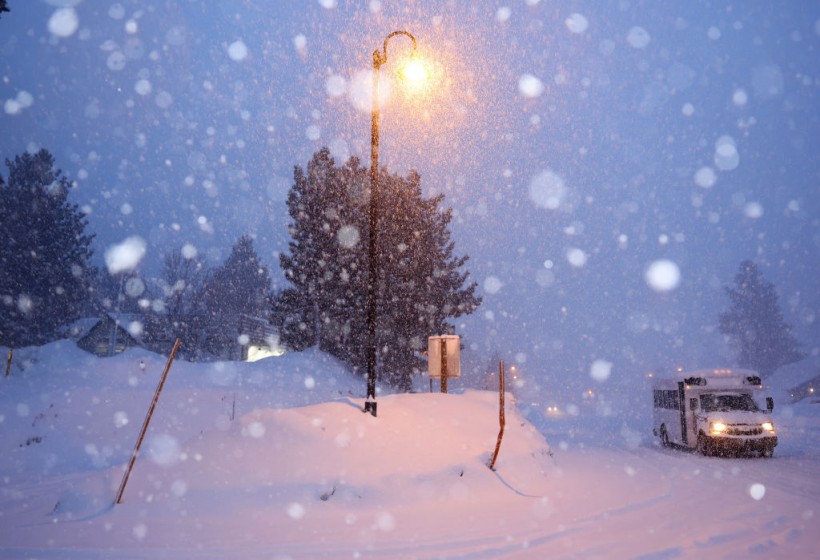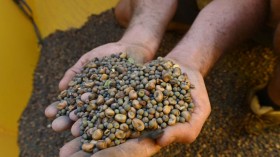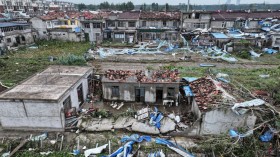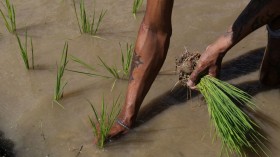According to a new study, as the world warms, America will likely see more killer tornado- and hail-spawning supercells, which will also strike more frequently in the more populous Southern states like Alabama, Mississippi, and Tennessee.
The supercell storm that devastated Rolling Fork, Mississippi, was an isolated occurrence that cannot be linked to climate change.
However, it fits the predicted and more dangerous pattern, which includes more nighttime strikes in a southern region with more people, poverty, and vulnerable housing than where storms hit last century. And the season will start a month earlier than usual.
Tornado-Spawning Storms May Get Worse Due To Warming
 (Photo : Mario Tama/Getty Images)
(Photo : Mario Tama/Getty Images)

Under a moderate level of future warming by the end of the century, the study in the Bulletin of the American Meteorological Society predicts a nationwide 6.6% increase in supercells and a 25.8% increase in the area and time the strongest supercells twist and tear over land, as per Phys.org.
But in certain areas in the South, the increase is much higher.
This includes Rolling Fork, where researchers predict an increase of one supercell per year by 2100.
According to lead author Walker Ashley, a professor of meteorology and disaster geography at Northern Illinois University, supercells are nature's ultimate storms, so-called "Finger of God" whoppers that are "the dominant producers of significant tornadoes and hail."
Supercells are tall, anvil-shaped storms that fill the sky with a rotating powerful updraft of wind that can last for hours.
Supercells were responsible for the 2013 Moore, Oklahoma, tornado, which killed 51 people, the 2011 Joplin, Missouri, tornado outbreak, which killed 161 people, and the 2011 Mid-South super outbreak, which killed more than 320 people in Alabama, Mississippi, and Tennessee.
The study used computer simulations to predict what would happen at various levels of global carbon pollution by the end of the century. However, Ashley believes that a stormier future is already here.
Ashley said in an interview three days before an EF-4 tornado killed more than 20 people in Mississippi on Friday, "The data that I've seen has persuaded me that we are in this experiment and living it right now." What we're seeing, in the long run, is happening right now.
Although the Mississippi tornado fit the projected pattern, Ashley and others pointed out that it was a single weather event, which differs from climate projections over many years and a large area.
Ashley and study co-author Victor Gensini, a meteorology professor at Northern Illinois University and a longtime tornado expert, are keeping an eye out for another supercell to form in the Mid-South on Friday.
Previous research has been unable to predict supercells and tornadoes in future climate simulations because they are small-scale events, particularly tornadoes, that global computer models cannot see.
Ashley and Gensini used smaller regional computer models and compensated for their limited computing power by running simulations and crunching data for two years.
It makes sense, according to three scientists who were not involved in the study.
According to Ashley and Gensini, the eastward shift puts more people at risk because those areas are more densely populated than the traditional tornado alley of Kansas and Oklahoma.
The population that is more vulnerable is also poorer and more frequently lives in mobile or manufactured homes, which are more dangerous places to be in a tornado.
According to Ashley and Gensini, the Southwest United States is likely to become hotter and drier as the climate warms.
Meanwhile, the Gulf of Mexico, which provides critical moisture for storms, is heating up, and the air coming from it is becoming juicier and more unstable.
Also Read: Climate Change is Killing Bumblebees as Early Spring Forces Shortened Hibernation
Extreme Weather and Climate Change
Total direct costs, both insured and uninsured, are calculated by NOAA and include physical damage to residential, commercial, and government buildings, material assets within buildings, public infrastructure, vehicles and boats, offshore energy platforms, and agricultural assets, as well as business interruption losses and disaster restoration and wildfire suppression costs.
These estimates exclude losses to natural capital, healthcare costs, and the values associated with loss of life, as per C2ES.
Climate change is expected to exacerbate the frequency, intensity, and consequences of certain types of extreme weather events.
For example, rising sea levels exacerbate the effects of coastal storms, and warming can put additional strain on water supplies during droughts.
Related article: How Previous El Niños Revealed Crucial Information About Climate Change
© 2024 NatureWorldNews.com All rights reserved. Do not reproduce without permission.





